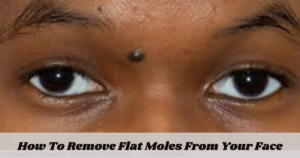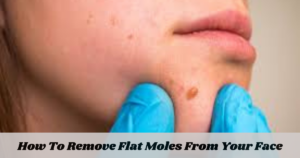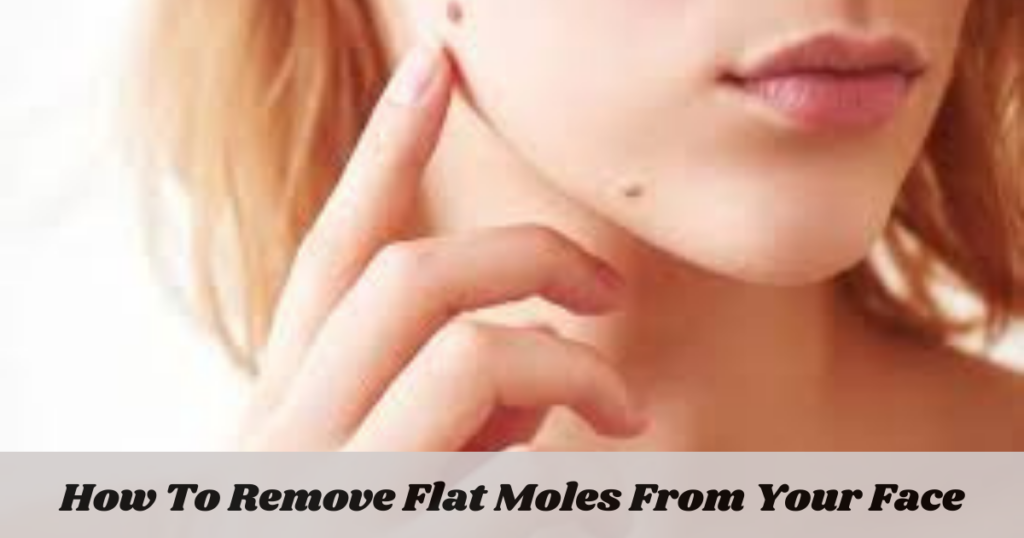Flat moles, also known as melanocytic nevi, are a common skin concern, particularly noticeable on the face. While they’re usually harmless, some individuals may choose to have them removed for aesthetic reasons or due to concerns about appearance. However, before learning how to remove flat moles from your face, it’s crucial to understand what flat moles are and how to identify them.

1. Understanding Flat Moles:
Flat moles are smooth or slightly raised patches of skin with a uniform color. Unlike some other types of moles, they don’t typically have a noticeable bump or uneven borders. They can range in size from a pinhead to a pea and appear anywhere on the face. Flat moles differ from other mole types in terms of risk factors. While some moles can be a sign of melanoma (skin cancer), flat moles are generally considered low-risk.
2. Identifying Flat Moles:
Identifying flat moles on your face requires vigilance. Here’s what to look for:
- Size: Flat moles are typically smaller than 6 millimeters (about the width of a pencil eraser).
- Shape: They can be round, oval, or irregular in shape.
- Color: Flat moles usually appear tan, brown, or black, with a consistent color throughout.
Regular self-examination is key. Pay attention to any changes in a mole’s size, shape, color, or border. The ABCDE rule of melanoma can be a helpful reminder:
- Asymmetry: Does one half of the mole look different from the other?
- Border: Is the border irregular or blurry?
- Color: Is the color uneven throughout the mole, with different shades of brown, black, or red?
- Diameter: Is the mole larger than 6 millimeters (about the width of a pencil eraser)?
- Evolving: Has the mole changed in size, shape, or color over time?
If you notice any irregularities or bleeding, it’s crucial to consult a dermatologist.
3. Consulting a Dermatologist: Why It’s Essential
Before attempting any removal method for a flat mole on your face, consulting a dermatologist is essential. A dermatologist can examine the mole and determine the best course of action. Professional assessment offers several benefits:
- Accurate Diagnosis: Dermatologists can ensure the mole is indeed benign and rule out any potential concerns for melanoma or other skin cancers. This peace of mind can be invaluable.
- Personalized Recommendations: Depending on the mole’s characteristics, your skin type, and your individual needs, a dermatologist can suggest the safest and most effective removal method. They can also discuss potential scarring risks associated with each method and help you choose the option that aligns best with your cosmetic goals.

4. How To Remove Flat Moles From Your Face: A Closer Look
Several safe and effective methods exist for removing flat moles on the face. Here’s an in-depth exploration of some popular options:
Surgical Excision:
This is a common removal method typically performed under local anesthesia in a dermatologist’s office. During the procedure, the dermatologist numbs the area and uses a scalpel to remove the mole and a small margin of surrounding skin. The wound is then closed with stitches.
Advantages:
- Effective and reliable for complete mole removal.
- Allows for examination of the entire mole tissue under a microscope to ensure complete removal and rule out any abnormalities.
Drawbacks:
-
May leave a scar, although the skill of the dermatologist and proper wound care can minimize scarring.
-
Requires stitches and a longer recovery time (typically 7-10 days) compared to some other methods.
Laser Removal:
Laser therapy uses concentrated light beams to target and break down the pigment cells within the mole. The laser beam vaporizes the mole tissue layer by layer. This procedure is often performed in a dermatologist’s office and may require multiple sessions depending on the size and depth of the mole.
Advantages:
- Minimally invasive and generally well-tolerated, often requiring only topical anesthetic.
- Offers minimal scarring potential in experienced hands.
Drawbacks:
-
May not be suitable for all types of flat moles, particularly larger or deeper ones.
-
Multiple sessions might be necessary for complete removal.
-
Can be more expensive compared to other methods.
Cryotherapy:
This procedure involves freezing the mole with liquid nitrogen to destroy its tissue. The extremely cold temperature damages the mole cells, causing them to die and eventually slough off. Cryotherapy is typically performed in a dermatologist’s office and requires minimal downtime.
Advantages:
- Relatively quick and often requires only topical anesthetic.
- Suitable for smaller flat moles.
Drawbacks:
- May leave faint scarring, especially on areas of the face prone to scar formation.
- Not always predictable in terms of complete mole removal, and there’s a chance the mole may grow back.
Topical Treatments:
Prescription and over-the-counter topical creams containing ingredients like hydroquinone, retinoids, or alpha hydroxy acids can help lighten the appearance of flat moles over time. These creams work by gradually breaking down melanin, the pigment that gives moles their color.
Advantages:
- Non-invasive and painless option.
- May be suitable for individuals who are not comfortable with surgical procedures or laser removal.
Drawbacks:
- Results can take several months to become noticeable and may be subtle.
- Not effective for complete mole removal, only for lightening the appearance.
- May cause skin irritation in some individuals.
5. Natural Remedies: A Word of Caution
Some natural remedies like apple cider vinegar, garlic, and castor oil are touted for lightening flat moles. However, there’s limited scientific evidence to support their effectiveness. These remedies may also irritate your skin and potentially cause burns or scarring. Consulting a dermatologist before using any natural remedies on your face is crucial, as they can advise on potential risks and recommend safer alternatives.
6. Monitoring for Changes: Aftercare is Key
Regardless of the removal method used, monitoring the area for changes is essential. Following removal, keep an eye out for signs of infection, such as redness, swelling, or pus. These could indicate improper healing and require prompt medical attention from your dermatologist. Here are some aftercare tips to promote healing and minimize scarring:
- Keep the area clean and dry: Gently cleanse the treated area with a mild soap and water according to your dermatologist’s instructions. Avoid harsh scrubbing or rubbing.
- Apply petroleum jelly: Use a petroleum jelly-based ointment like petroleum jelly or Aquaphor to keep the area moist and aid healing.
- Avoid sun exposure: Sun exposure can worsen scarring. Protect the treated area with sunscreen with SPF 30 or higher for several weeks after removal, as directed by your dermatologist.
- Don’t pick or scratch the area: This can increase the risk of infection and scarring.
7. When to See a Doctor
Any changes in the mole’s appearance, such as rapid growth, bleeding, or color variation, also warrant immediate medical attention. These changes could be signs of a more serious skin condition and should be evaluated by a dermatologist.
Conclusion
Understanding flat moles and their characteristics is crucial before considering removal. Consulting a dermatologist for professional assessment and personalized recommendations is the safest course of action. The good news? When done under professional supervision, removing flat moles from the face can be a safe and straightforward process. There are various effective removal methods available, each with its advantages and drawbacks. By discussing your concerns and cosmetic goals with your dermatologist, you can choose the method that best suits your needs.

